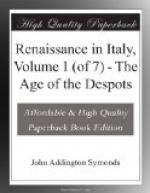Not one is insignificant. Not one but indicates some moment of importance in the social evolution of the state. Not one but speaks of civil strife, whereby the burgh in question struggled into individuality and defined itself against its neighbor. Like fossils, in geological strata, these names survive long after their old uses have been forgotten, to guide the explorer in his reconstruction of a buried past. While one town appears to respect the feudal lordship of great families, another pronounces nobility to be a crime, and forces on its citizens the reality or the pretense of labor. Some recognize the supremacy of ecclesiastics. Others, like Venice, resist the least encroachment of the Church, and stand aloof from Roman Christianity in jealous isolation. The interests of one class are maritime, of another military, of a third industrial, of a fourth financial, of a fifth educational. Amalfi, Pisa, Genoa, and Venice depend for power upon their fleets and colonies; the little cities of Romagna and the March supply the Captains of adventure with recruits; Florence and Lucca live by manufacture; Milan by banking; Bologna, Padua, Vicenza, owe their wealth to students attracted by their universities. Foreign alliances or geographical affinities connect one center with the Empire of the East, a second with France, a third with Spain. The North is overshadowed by Germany; the South is disquieted by Islam. The types thus formed and thus discriminated are vital, and persist for centuries with the tenacity of physical growths. Each differentiation owes its origin to causes deeply rooted in the locality. The freedom and apparent waywardness of nature, when she sets about to form crystals of varying shapes and colors, that shall last and bear her stamp for ever, have governed their uprising and their progress to maturity. At the same time they exhibit the keen jealousies and mutual hatreds of rival families in the animal kingdom. Pisa destroys Amalfi; Genoa, Pisa; Venice, Genoa; with ruthless and remorseless egotism in the conflict of commercial interests. Florence enslaves Pisa because she needs a way to the sea. Siena and Perugia, upon their inland altitudes, consume themselves in brilliant but unavailing efforts to expand. Milan engulfs the lesser towns of Lombardy. Verona absorbs Padua and Treviso. Venice extends dominion over the Friuli and the Veronese conquests. Strife and covetousness reign from the Alps to the Ionian Sea. But it is a strife of living energies, the covetousness of impassioned and puissant units. Italy as a whole is almost invisible to the student by reason of the many-sided, combative, self-centered crowd of numberless Italian communities. Proximity foments hatred and stimulates hostility. Fiesole looks down and threatens Florence. Florence returns frown for frown, and does not rest till she has made her neighbor of the hills a slave. Perugia and Assissi turn the Umbrian plain into a wilderness of wolves by their recurrent warfare. Scowling




